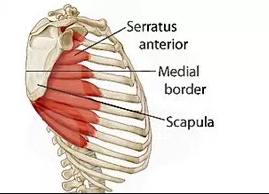Sports Injuries and Management
Spotlight On The Serratus Anterior Muscle
Serratus Anterior: A Fan shaped Muscle
Serratus anterior is a fan shaped muscle situated at the lateral wall of the thorax. Drawing its name from the latin serrare meaning to saw, a name which references the shape and location of the muscle appearing serrated and anterior which refers to it being found on the front side of the body. The serrated nature of the muscle and its position is shown by the figure below, where you can also see that the main part of the muscle lies deep under the scapula and pectoral muscles (not pictured). Specifically the origins of the muscle are on the surface of the first 8 to 9 ribs at the side of the chest and the insertion is along the anterior border of the shoulder blade (scapula) closest to the spine.
- To feel the muscle working palpate in the space between the pectoralis major and latissimus dorsi muscles on your lateral chest wall just below the arm pit area. Feeling for the muscle contraction by keeping your fingers of the palpating hand in position whilst performing a punching/pressing movement with your arm, doing so you should relatively easily be able to feel movement/contraction underneath your fingertips.
Function Of The Boxer’s Muscle
Serratus anterior is sometimes referred to as the “boxer’s muscle” because it is largely responsible for protraction of the scapula (the motion that is pulling the shoulder blade forwards around the rib cage), a movement necessary when “throwing” a punch. When the serratus anterior muscle contracts it works to pull your scapula forward and around the rib cage. As well as this contraction of the muscle helps in keeping the scapula pressed snugly against the thorax, so the inside border of the shoulder blade doesn’t fan outwards, a shoulder blade position / movement referred to as a winging which is generally considered an undesirable phenomena I will discussed at a later date in another blog. Appropriate action of the serratus anterior muscle allows the shoulder blade to move around the rib cage hugging the thorax on the way and is vital to the action of raising your arms up and lifting objects above head height.
- When the shoulder blades are held in a fixed position the serratus anterior muscle can help lift the rib cage meaning it can also act as an accessory muscle to breathing.
Situations Where The Serratus Anterior Muscle Doesn’t “Fire Correctly”
Mastectomy and other surgical procedures in and around the thorax can cause injury to the nerve supplying serratus anterior known as the long thoracic nerve. Damage to this nerve and the resulting denervation of the muscle can result in telltale scapular winging and a reduced power and /or ability to raising the arm above the head. The same nerve can also be injured when carrying a heavy backpack across your shoulders, or the result of trauma causing similar dysfunctional scapula movements and reduced function. Physiotherapy can in some situations assist in helping people regain control of their serratus anterior muscle following nerve injury, however this depends on the severity of damage and the capacity for the nerve to regenerate following any trauma.
Disclaimer: Sydney Physio Clinic does not endorse any treatments, procedures, products mentioned. This information is provided as an educational service and is not intended to serve as medical advice. Anyone seeking specific advice or assistance regarding Spotlight On The Serratus Anterior Muscle should consult his or her general practitioner, sports medicine specialist, or physiotherapist.



